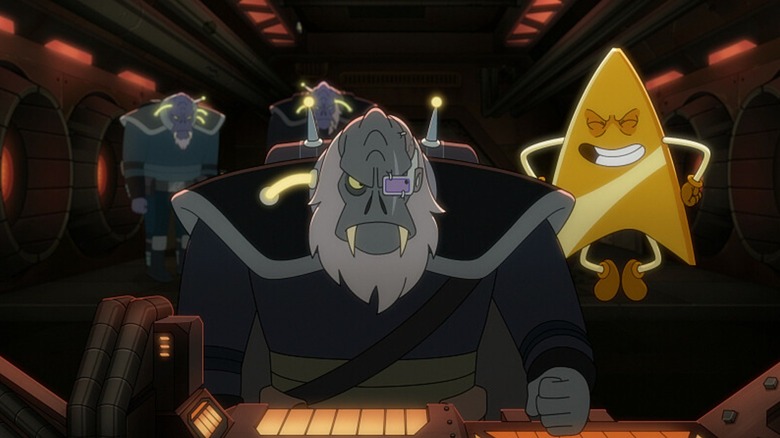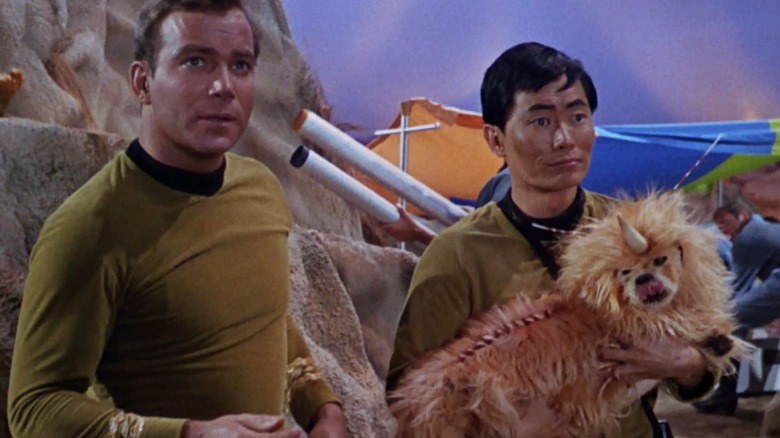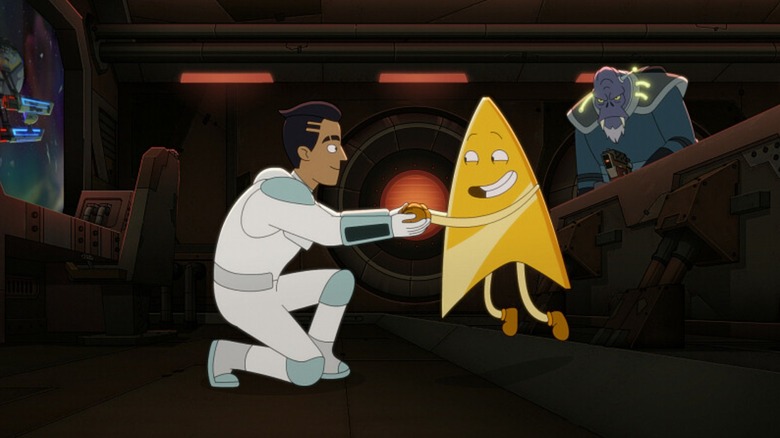Star Trek: Lower Decks Revives A Classic Original Series Premise
This post contains spoilers for "Star Trek: Lower Decks."
"Star Trek: Lower Decks" loves a reference. If viewers were to try to count the number of inter-franchise references dropped at rapid-speed in a single episode of the animated comedy, they'd likely lose count. Sometimes the fannish U.S.S. Cerritos crew calls attention to the show's homages and callbacks, but other times (rarely, given how loudmouthed the Lower Deckers are), they play out without comment. That was the case this week when, in keeping with the show's seventh episode of the season tradition, rogue tech once again tried to take over the world.
Not only did polarizing, villainous Exocomp Peanut Hamper (Kether Donohue) return in the latest episode, but so did evil computer AGIMUS (Jeffrey Combs) and corrupted AI hologram Badgey (Jack McBrayer). In an episode that plays around with longstanding "Star Trek" ideas about rogue sentient technology, the Cerritos crew spends much of their time in "A Few Badgeys More" trying to figure out if any of these former bad guys of the week have actually reformed themselves. Things get a lot more complicated, though, when Badgey pulls an "Enemy Within."
Badgey went full Enemy Within
"The Enemy Within" is one of the most memorable episodes of "Star Trek: The Original Series," in part because when Captain Kirk ends up split into two halves, one villainous and one heroic, William Shatner goes even more all in than usual on the performance. The episode comes early in the series' first season, showing would-be fans that the series was capable of being a lot zanier than expected. Personally, I also love "The Enemy Within" because it sets an early precedent for some truly shaky (but very fun) science. "Star Trek" predicted and inspired major technological changes, sure, but it also featured an episode where a transporter split someone up not anatomically or on a molecular level, but according to the makeup of their soul. It's classic "Star Trek" through and through.
"Star Trek: Lower Decks" takes that premise to the next level, as Badgey splits into not two but three selves. First, a hug and apology from Rutherford (Eugene Cordero) inspires the rogue AI to briefly "turn good" before, as Rutherford puts it, "Badgey took all the goodness in his code and split it off into Goodgey." Goodgey is sweet and silver and, though the contrast in McBrayer's performance isn't as drastic as Shatner's, it's still easy to tell which badge is which since only one wants to take a root beer float break.
A three-way split
Unlike evil Kirk, who is irrational by nature ("The Enemy Within" presents Kirk's logical self as intrinsically linked to his better half), Badgey is still beholden to logic. So when Rutherford asks what he would get out of killing his friends, Badgey realizes the answer is nothing, and forces the creation of a third representation of himself, Logicy. The bad guy soon breaks the poor copper badge's spine, but his evil scheme is cut short once he gains ultimate power. In another realistic riff on power-hungry "Star Trek" villains of the past, once Badgey has all the knowledge of the universe, he immediately doesn't care about being evil anymore. Instead, he retires to the big koala in the sky, becoming a sort of god. That never happened to evil Kirk, but I would've loved to have seen it.
"Star Trek: Lower Decks" doesn't get too deep into the science behind Badgey's "Enemy Within" moment, but it's worth noting that he was running thanks to scavenged holo-emitters, and it was a transporter malfunction that led to Kirk's split in the original series. Regardless, the Badgey plot was definitely the more compelling of this week's arcs, and McBrayer is one of the show's most endearing guest stars. Personally, I could do without more rogue tech episodes, but I hope this isn't the last we've seen of Goodgey.
New episodes of "Star Trek: Lower Decks" premiere Thursdays on Paramount+.


